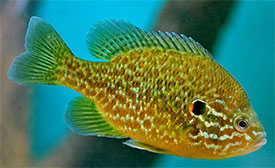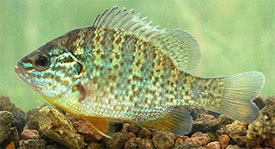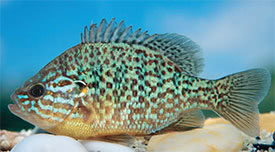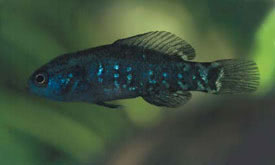
 Magyarul / Hungarian
Magyarul / Hungarian




- Scientific name: Lepomis gibbosus
- Synonyms: Perca gibbosa, Eupomotis gibbosus, Lepomus gibbosus, Pomotis vulgaris
- Common name: Pumpkinseed, Common Sunfish
- Group: Cichlids
- Habitat: North America: New Brunswick in Canada to South Carolina in the USA. It has been widely introduced in Europe, Africa, and South America.
- Size: 15-25 cm
- Biotope: Found in vegetated lakes and in slow-moving parts of creeks and small rivers, usually near the shore, in the shallow water.
- Social behavior: Quite aggressive fish, that shouldn’t be kept in a community tank, as it will eat smaller fish. They can become more aggressive and territorial during spawning, and they often fight during this time.
- Diet: Carnivorous; In the nature they feed on small fishes and other invertebrates, as well as fish eggs. It will take all kinds of live and frozen foods in the aquarium, and usually it accepts dried foods.
- Breeding: Quite hard
- Tank: Minimum 250 litres
- Population: 1 pair for 300 litres
- Decoration: In the aquarium these fish can be quite destructive as they mature, and will rearrange the tank, so use larger stones and roots to decorate the aquarium, and secure them carefully. They will often tear up plants.
- Temperature: 4-22 °C
- pH: 7-7.5
- Hardness: 10-15 NK°
- Lifespan: 8-12 years
Description: Common Sunfish is dark, olive-green on its back, and yellowish on its sides with mottled pattern, covered with orange, red and blue spots. Its belly is yellow to bright orange. The head and gill covers are marked with blue-green and yellow worm-shaped bands. There is a black opercular spot with a red mark at the outside edge on its bluish-black gill cover. Orange spots may cover the dorsal, anal, and caudal fins. Young pumpkinseeds also have vertical chainlike bands down their sides with dark vertical bars between the primary bands. Common Sunfish has very sharp spines in the dorsal and anal fins, which protects the fish from the predators.
Lepomis gibbosus is a true coldwater fish, so their aquarium should be palced in a cool place during the summertime, because they will not tolerate high temperatures for long. Pumpkinseeds are considered a pest in many countries where they have been introduced as they cause an adverse ecological impact and could outcompete native fishes. Common Sunfish can hybridize with most other Lepomis, and these hybrids are fast-growing, but sterile. Although many people consider the meat of a pumpkinseed to be good tasting, it is typically not a popular sport fish due to its small size.
The males are a bit thinner, and more colorful, and the spot on the gill cover is a bit smaller in females, but even experienced breeders have a hard time to distinguish between the genders. Lepomis gibbosus can only be bred if the fish have been kept cool enough during the winter. It’s easier to achieve in garden ponds where the fish will usually spawn, and every year a number of juveniles will survive. They can be bred in pairs in a larger aquarium that should be densley planted, where the female can hide. The male will establish a territorium, where the male will dig a spawning pit in the substrate. To breed the fish the temperature should be kept at 20 °C. After a short courtship the female lays usually 1000 eggs in the pit, and the male fertilizes them. Often more than one female use the same nest. A female between 2 to 5 years of age can produce anywhere from 4000 to 7000 eggs in a single season! The female should be removed after spawning since the male will become extremely aggressiv and may even kill her. Eggs can hatch in 3 days and the fry become free-swimming after another 5 days. The male will care for the eggs and the fry until they are free swimming, but after that he may consider the fry as food, so he should be removed. The fry can immediately be fed with small live foods, and grow quite fast. They can be bred after a year, although the adult size is reached in the second or third year.




